The Skylake Core i3 (51W) CPU Review: i3-6320, i3-6300 and i3-6100 Tested
by Ian Cutress on August 8, 2016 9:00 AM ESTMiddle-Earth: Shadow of Mordor
The final title in our testing is another battle of system performance with the open world action-adventure title, Shadow of Mordor. Produced by Monolith using the LithTech Jupiter EX engine and numerous detail add-ons, SoM goes for detail and complexity to a large extent, despite having to be cut down from the original plans. The main story itself was written by the same writer as Red Dead Redemption, and it received Zero Punctuation’s Game of The Year in 2014.
For testing purposes, SoM gives a dynamic screen resolution setting, allowing us to render at high resolutions that are then scaled down to the monitor. As a result, we get several tests using the in-game benchmark, taking results as the average and minimum frame rates. Minimum frame rate results can be found in Bench.
For this test we used the following settings with our graphics cards:
| Shadow of Mordor Settings | |||
| Resolution | Quality | ||
| Low GPU | Integrated Graphics | 1280x720 | Low |
| ASUS R7 240 1GB DDR3 | |||
| Medium GPU | MSI GTX 770 Lightning 2GB | 1920x1080 | Ultra |
| MSI R9 285 Gaming 2G | |||
| High GPU | ASUS GTX 980 Strix 4GB | 1920x1080 3840x2160 |
Ultra Ultra |
| MSI R9 290X Gaming 4G | |||
Integrated Graphics
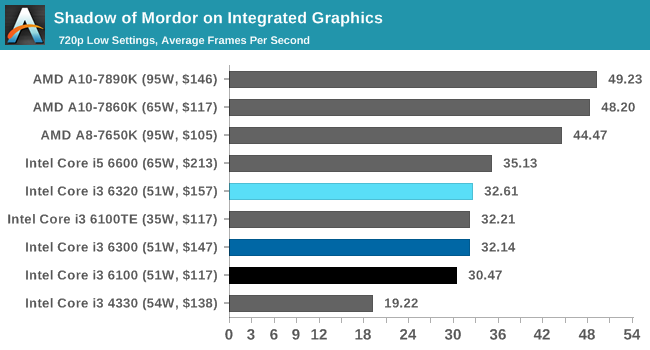
As with the other IGP tests, the APU solution gets significantly better results.
Discrete Graphics
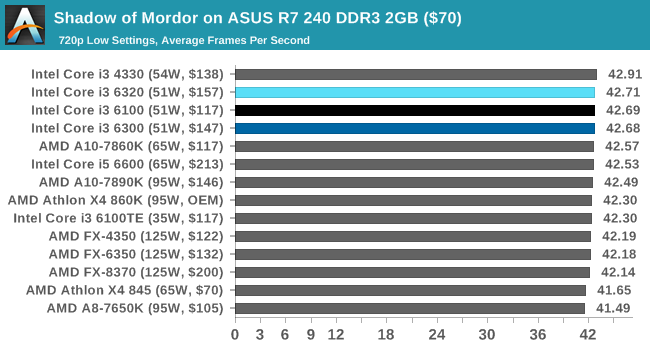
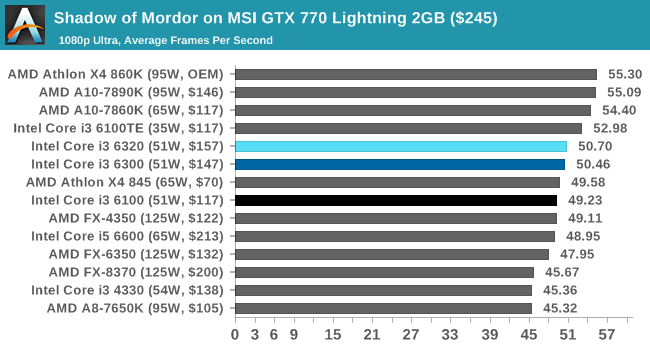

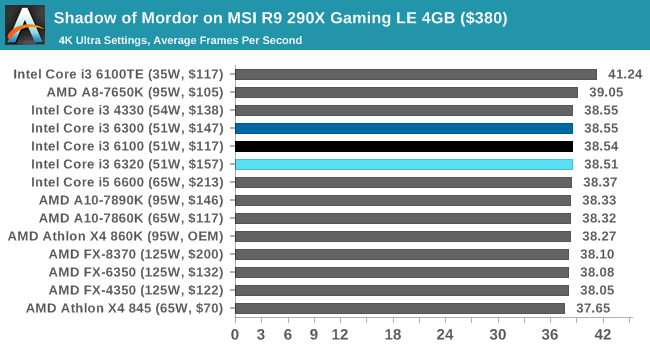
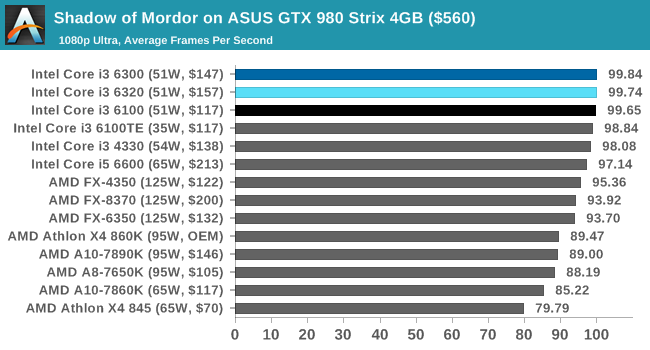
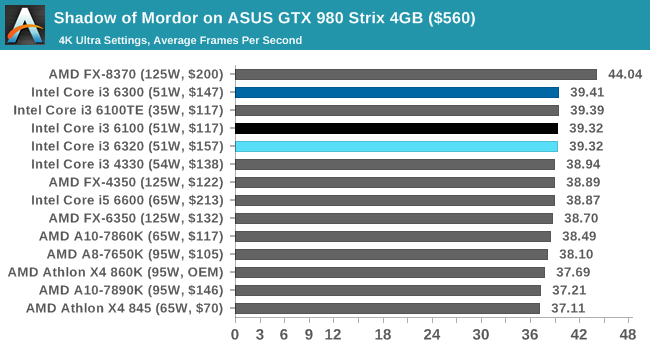
SoM is our most CPU agnostic benchmark of the set, such that as you increase the GPU power and the resolution, the CPU matters less to the performance. This is why at 4K Ultra, with both the AMD and NVIDIA discrete GPUs, the $70 CPU from AMD is within 2-3% for average frame rates.
However, it should be noted that the CPU power matters more when (a) an AMD discrete GPU is being used, or (b) lower resolutions. In both cases, the AMD FX CPUs are more likely to match up with Intel's Core i3, which sit at the top of the pack.











94 Comments
View All Comments
Ratman6161 - Monday, August 8, 2016 - link
I don't understand your point. Did you note how many of the tests where the i3's (sometimes just the 6320 and sometimes all of them) beat the i5? Also look at certain gaming tests where an i3 with a better graphics card beats an i5 with a lesser graphics card...i.e. if you save $100 on the CPU and put that towords the graphics instead, you sometimes come out ahead overall.Finally, I know plenty of people who are just using their PC for web surfing, email, MS Office, etc where they would not notice any difference between an i3-6100 and an i5-6600K other than the fact that it cost almost $100 more. Sometimes good enough is good enough and thats where the i3 comes in.
extide - Monday, August 8, 2016 - link
Yeah, the i3's sometimes beat the i5's because when moving from the top end i3 to the bottom end i5 you lose quite a bit of frequency, but you gain two physical cores. So, if something is very lightly threaded then it may perform better on the i3.beginner99 - Tuesday, August 9, 2016 - link
True but for the mentioned usage you can step down to a Pentium or even Celeron and save even more and not notice much of a difference.BillBear - Sunday, August 14, 2016 - link
I agree. If Android can manage to leverage many small ARM cores for common tasks like web browsing, there is no excuse for Microsoft not being able to manage the same feat on Windows.http://www.anandtech.com/show/9518/the-mobile-cpu-...
xenol - Monday, August 8, 2016 - link
Please, do more lower-end CPU reviews! This data helps me understand how software and hardware play together more and more.To those thinking that it's sad that performance hasn't really increased in the past few years, maybe this is more of a sign that games are becoming efficient. If anything, this means your hardware will go a lot longer than before. Think about it, if the i5-2500K is still a viable CPU, think about how long an i5-6600K will last.
Philotech - Monday, August 8, 2016 - link
I'd love to see the same comparison for the mobile variants of the i3/i5 chips, in particular the 15W variants suitable for ultrabooks and MacBook Pros.Looks like for desktops, as a mainstream user there is no need to look beyond the i3. How about mobile? Looking at Intel's ARK database, there aren't that many 15w i3s (one, actually, 6100U), but a few i5s (four).
dave_the_nerd - Monday, August 8, 2016 - link
That seems tough - since they're soldering into the chassis, and different cooling can result in throttling and very different performance numbers even from the same chips. It'd be really hard to make a fair CPU-to-CPU comparison.Philotech - Monday, August 8, 2016 - link
Hm, you're right probably. Seeing how small the differences between the desktop i3s and i5 is, I'm wondering if it makes any sense at all to judge a laptop or ultrabook by its CPU, in particular taking into account your point, i.e. that probably cooling (and selecting a higher or lower TDP by the manufacturer) makes much more of a difference than the CPU model.extide - Monday, August 8, 2016 - link
Well, in the mobile chips the segmentation is different. In the desktop world going from i3 to i5 you gain two cores, lose hyper threading, and gain turbo boost.In the mobile chips everything has hyper threading. Going from i3 to i5 gains you turbo boost on a mobile chip and that can be pretty significant, because on those really low TDP chips they tend to have a pretty low base speed but the ones that can boost can usually boost up quite a bit. Going to an i7 in the 15w chips add's a bit more clockspeed and you will typically move from 3MB of L3 to 4MB of L3. The best value are the i5's in the mobile world because turbo boost helps a lot, but moving to an i7 with 4MB of L3 doesnt really gain that much performance, and can be pretty costly.
So, you can't really use these results to judge the differences between mobile i3's and i5's because they are quite different.
slickr - Monday, August 8, 2016 - link
I'm waiting for AMD's Zen CPU's before I upgrade my CPU. I'm running an older I5 3330, but so far nothing is really significantly faster for the same price I bought it at the time(180 euros). Especially in games the difference seems negligible and mostly comes down to GPU.So I'm waiting on Zen as my next likely upgrade.